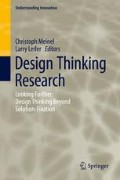Abstract
We now appear to be in the full grip of the media transformation from paper-based media to a digital-based media. This evolution in mobility of information (experiences) has occurred alongside the mobility of matter and labor (goods and services, mass and heat), all of which have come about as a result of evolution in technologies of encryption, computation, communication, representation, sensing, and transportation. All these changes have contributed to a market environment that is more open, connected, complex, and dynamic, and to corporate and civic organizational configurations that are overwhelmed and slow to adapt to these changes. In the Hasso Plattner Design Thinking Research program, we have been observing these changes, and developing solutions to accelerate the rate of innovation in the new digital economy. Our work has led us to focus on the design team, the design coach, and the instrumented design space as the new unit of knowledge work, as opposed to the individual employees and line manager. This new unit is larger than the individual and so can take in more information. It is smaller than the typical organizational group or department, so it is faster to act and more agile. And the data rich and computational nature of the instrumented space, means that the technology can be considered a bona fide member of the design team. The variety of organizational structures now possible as well as the way these structures need to change in very short time frames has made it necessary to develop a biological metaphor of the organization as an organism that can fold, unfold, and refold as it adapts rapidly to a fast-changing environment. This radical shift from the hierarchical, clockwork, command and control organizations of the industrial age, will be explored with a view to showing alternative redesign of social organizations and the means to accomplish the requisite sociological, psychological, and technological transformations effectively.
Access this chapter
Tax calculation will be finalised at checkout
Purchases are for personal use only
References
Amabile, T. M. (1997). Motivating creativity in organizations: On doing what you love and loving what you do. California Management Review, 40(1), 39–58.
Bush, V. (1945). As we may think. The Atlantic Monthly, 176(1), 101–108.
Drucker, P. (1969). The age of discontinuity: Guidelines to our changing society. Somerset, NJ: Transactions Publishing.
Engelbert, D. (1968). A research center for augmenting human intellect. Fall Joint Computer Conference FJCC 1968. San Francisco, CA (pp. 395–410).
Foucault, M. (1977). Discipline and punish (A. Sheridan, trans.). New York: Pantheon.
Hwang, W., & Horowitt, G. (2012). The rainforest: The secret to building the next Silicon Valley. Los Altos Hills, CA: Regenwald.
Ingold, T. (2009). Against space: Place, movement, knowledge. In Boundless worlds: An anthropological approach to movement (pp. 29–43).
Katz, D., & Kahn, R. L. (1978). The social psychology of organizations (Vol. 2, p. 528). New York: Wiley.
Kolko, J. (2015). Design thinking comes of age. Harvard Business Review, 93(9), 66–71.
Köppen, E., Schmiedgen, J., Rhinow, H., & Meinel, C. (2016). Thisisdesignthinking.net: A storytelling-project. In Design thinking research (pp. 13–15). Cham: Springer.
Kurtz, C. F., & Snowden, D. J. (2003). The new dynamics of strategy: Sense-making in a complex and complicated world. IBM Systems Journal, 42(3), 462–483.
Maier, S. F., & Seligman, M. E. (1976). Learned helplessness: Theory and evidence. Journal of Experimental Psychology: General, 105(1), 3.
Parunak, H. V. D. (2005, July). A survey of environments and mechanisms for human-human stigmergy. In International workshop on environments for multi-agent systems (pp. 163–186). Berlin: Springer.
Roth, B. (2015). The achievement habit: Stop wishing, start doing, and take command of your life. Harper Collins.
Saxenian, A. (1996). Regional advantage. Cambridge: Harvard University Press.
Schmiedgen, J., Rhinow, H., & Köppen, E. (2016). Parts without a whole?: The current state of design thinking practice in organizations (Vol. 97). Potsdam: Universitäts verlag Potsdam.
Sonalkar, N., Mabogunje, A., Hoster, H., & Roth, B. (2016). Developing instrumentation for design thinking team performance. In Design thinking research (pp. 275–289). Cham: Springer.
Tapscott, D., & Tapscott, A. (2017). How blockchain will change organizations. MIT Sloan Management Review, 58(2), 10.
Theraulaz, G., & Bonabeau, E. (1999). A brief history of stigmergy. Artificial Life, 5(2), 97–116.
Author information
Authors and Affiliations
Corresponding author
Editor information
Editors and Affiliations
Rights and permissions
Copyright information
© 2019 Springer Nature Switzerland AG
About this chapter
Cite this chapter
Mabogunje, A., Sonalkar, N., Leifer, L. (2019). Redesigning Social Organization for Accelerated Innovation in the New Digital Economy: A Design Thinking Perspective. In: Meinel, C., Leifer, L. (eds) Design Thinking Research. Understanding Innovation. Springer, Cham. https://doi.org/10.1007/978-3-319-97082-0_8
Download citation
DOI: https://doi.org/10.1007/978-3-319-97082-0_8
Published:
Publisher Name: Springer, Cham
Print ISBN: 978-3-319-97081-3
Online ISBN: 978-3-319-97082-0
eBook Packages: Business and ManagementBusiness and Management (R0)

